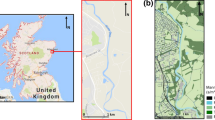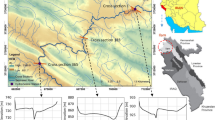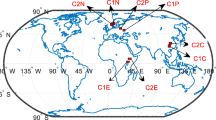Abstract
This study uses uncertainty propagation in real flood events to derive a probabilistic flood map. The flood event of spring 2017 in Quebec was selected for this analysis, with the computational domain being a reach of the Mille Iles River. The main parameter deemed uncertain in this work is the upstream water discharge; a given value of this discharge is utilized to build a random sample of 500 scenarios using the Latin hypercube sampling method. Simulations were run using CuteFlow-Cuda, an in-house finite volume-based shallow water equations solver, to derive the statistical mean and the standard deviation of the free surface elevation and the water depth at each node. For this real flood case, the initial interface flux scheme had to be adapted, combining a developed version of the scheme introduced by Harten, Lax and van Leer at wet interfaces and the Lax–Friedrichs scheme with additional free surface corrections for wet and dry transitions. Comparisons with results obtained from TELEMAC and from in situ observations show generally close predictions, and overall good agreement with observations. Errors of the free surface prediction relative to observations are less than 2.75%. A map based on the standard deviation of the water depth is presented to enhance the areas most prone to flooding. Finally, a flood map is produced, showing the flooded inhabited areas near the municipalities of Saint-Eustache and Deux Montagnes around the reach of the Mille Iles River as it overflows its natural bed.



















Similar content being viewed by others
Data availability
Not applicable.
Code availability
Not applicable.
References
Ahmadisharaf E et al (2018) A probabilistic framework to evaluate the uncertainty of design hydrograph: case study of Swannanoa River watershed. Hydrol Sci J 63(12):1776–1790. https://doi.org/10.1080/02626667.2018.1525616
Alfonso L, Mukolwe MM, Baldassarre D (2016) Probabilistic flood maps to support decision-making: mapping the value of information. Water Resour Res 52(3):1026–1043. https://doi.org/10.1002/2015WR017378
Alvarez H et al (2014) Impacts and adaptation to climate change using a reservoir management tool to a Northern Watershed: application to Lièvre River Watershed, Quebec, Canada. Water Resour Manag 28(11):3667–3680. https://doi.org/10.1007/s11269-014-0694-z
Arnaud P, Cantet P, Odry J (2017) Uncertainties of flood frequency estimation approaches based on continuous simulation using data resampling. J Hydrol 554:360–369. https://doi.org/10.1016/j.jhydrol.2017.09.011
Azeez O et al (2019) Dam break analysis and flood disaster simulation in arid urban environment: the Um Al-Khair dam case study. Nat Hazards 100:995–1011. https://doi.org/10.1007/s11069-019-03836-5
Baldassarre GD, Montanari A (2009) Uncertainty in river discharge observations: a quantitative analysis. Hydrol Earth Syst Sci 13:913–921
Beven K et al (2015) Communicating uncertainty in flood inundation mapping: a case study. Int J River Basin Manag 13(3):285–295. https://doi.org/10.1080/15715124.2014.917318
Beven K, Leedal D, McCarthy S (2011) Framework for assessing uncertainty in fluvial flood risk mapping. In: FRMRC research report SWP1.7
Chen J et al (2019) Risk analysis for real-time flood control operation of a multi-reservoir system using a dynamic Bayesian network. Environ Model Softw 111:409–420. https://doi.org/10.1016/j.envsoft.2018.10.007
Falter D et al (2015) Spatially coherent flood risk assessment based on long-term continuous simulation with a coupled model chain. J Hydrol 524:182–193. https://doi.org/10.1016/j.jhydrol.2015.02.021
Goutal N et al (2018) Uncertainty quantification for river flow simulation applied to a real test case: the Garonne valley. In: Advances in hydroinformatics, pp 169–187
Harten A, Lax PD, van Leer B (1983) On upstream differencing and Godunov-type schemes for hyperbolic conservation laws. SIAM Rev 25(1):35–61
Hervouet JM, Ata R (2017) User manual of opensource software TELEMAC-2D. EDF-R&D, Paris
Jacquier P, et al (2020) Non-intrusive reduced-order modeling using uncertainty-aware deep neural networks and proper orthogonal decomposition: application to flood modeling. arXiv:2005.13506
Jafarzadegan K, Merwade V (2019) Probabilistic floodplain mapping using HAND-based statistical approach. Geomorphology 324:48–61. https://doi.org/10.1016/j.geomorph.2018.09.024
Loukili Y, Soulaïmani A (2007) Numerical tracking of shallow water waves by the unstructured finite volume WAF approximation. Int J Comput Methods Eng Sci Mech 8(2):75–88. https://doi.org/10.1080/15502280601149577
Neal J et al (2013) Probabilistic flood risk mapping including spatial dependence. Hydrol Process 27(9):1349–1363. https://doi.org/10.1002/hyp.9572
Pedrozo-Acuña A et al (2015) Estimation of probabilistic flood inundation maps for an extreme event: Pánuco River, México. J Flood Risk Manag 8(2):177–192. https://doi.org/10.1111/jfr3.12067
Philips D (2018) Canada’s top ten weather stories 2017: CMOS bulletin. In: Canadian meteorological and oceanographic society. https://bulletin.cmos.ca/canadas-top-ten-weather-stories-2017/
Pourreza-bilondi M, Samadi SZ, Ghahraman B (2017) Reliability of semiarid flash flood modeling using Bayesian framework. J Hydrol Eng 22(4):1–16. https://doi.org/10.1061/(ASCE)HE.1943-5584.0001482
Prokof’ev VA, (2002) State-of-the-art numerical schemes based on the control volume method for modeling turbulent flows and dam-break waves. Power Technol Eng 36(4):235–242
Roy E, Rousselle J, Lacroix J (2003) Flood damage reduction program (FDRP) in Québec: case study of the Chaudière River. Nat Hazards 28(2–3):387–405. https://doi.org/10.1023/A:1022942427248
Saghafian B, Golian S, Ghasemi A (2014) Flood frequency analysis based on simulated peak discharges. Nat Hazards 71(1):403–417. https://doi.org/10.1007/s11069-013-0925-2
Sarhadi A, Soltani S, Modarres R (2012) Probabilistic flood inundation mapping of ungauged rivers: linking GIS techniques and frequency analysis. J Hydrol 458–459:68–86. https://doi.org/10.1016/j.jhydrol.2012.06.039
Soares-Frazao S, Sillen X, Zech Y (1998) Dam-break flow through sharp bends physical model and 2D Boltzmann model validation. In: Proceeding of the CADAM meeting, HR Wallingford, UK
Suthar AK, Soulaïmani A (2018) Technical report: parallelization of shallow water equations solver: CUTEFLOW. Department of Mechanical Engineering, École de Technologie Supérieure, Montreal, Quebec, Canada
Tanaka T et al (2017) Impact assessment of upstream flooding on extreme flood frequency analysis by incorporating a flood-inundation model for flood risk assessment. J Hydrol 554:370–382. https://doi.org/10.1016/j.jhydrol.2017.09.012
Tchamen GW (2006) L’utilisation des schémas de Riemann pour la solution des équations de Navier Stokes. École Polytechnique de Montréal, Montréal
Toro EF (2001) Shock capturing methods for free-surface shallow flows. Wiley, New York
Toro EF, Spruce M, Speares W (1994) Restoration of the contact surface in the HLL-Riemann solver. Shock Waves 4(1):25–34
Valentine A, Baron M (2018) Sensitivity analysis of secondary currents in Telemac-2D: a study case at the Danube River. In: Proceedings of the XXVth TELEMAC-MASCARET user conference, 9th to 11th October 2018, Norwich, pp 67–74
Zokagoa J-M, Soulaïmani A (2018) A POD-based reduced-order model for uncertainty analyses in shallow water flows. Int J Comput Fluid Dyn 32(6–7):278–292. https://doi.org/10.1080/10618562.2018.1513496
Zokagoa JM, Soulaïmani A (2010) Modeling of wetting-drying transitions in free surface flows over complex topographies. Comput Methods Appl Mech Eng 199(33–36):2281–2304. https://doi.org/10.1016/j.cma.2010.03.023
Acknowledgements
The authors gratefully acknowledge NSERC (National Science and Engineering Research Council of Canada) and Hydro-Québec (Direction Barrages et Infrastructures) for their financial support. They also wish to thank Calcul Québec and Compute Canada for their computational support, and the Montreal Metropolitan Community (Communauté Métroplitaine de Montréal) for supplying bathymetry data.
Author information
Authors and Affiliations
Contributions
Not applicable.
Corresponding author
Ethics declarations
Conflict of interest
Not applicable.
Additional information
Publisher's Note
Springer Nature remains neutral with regard to jurisdictional claims in published maps and institutional affiliations.
Appendix A: Procedure of the scheme order calculation using mesh refinement
Appendix A: Procedure of the scheme order calculation using mesh refinement
We consider the L2 error for a given mesh at time t:
where \(A_{e}\) and \(x_{G}^{e}\) are, respectively, the area and the barycenter of the element, and h is a measure of the mesh size defined as \(h = \max \left( {\sqrt {A_{e} } } \right)\). \(u_{h}\) represents the numerical solution (water level or velocity components) and \(u_{{{\text{exact}}}}\) is the corresponding exact solution.
We then calculate the error for the finest mesh possible (i.e., \(h \approx 0\)): \(L(t,0)^{2}\).
The theoretical error analysis gives the following relation:
where \(\beta\) is the space-order of the scheme that can be found by calculating:
Finally, \(\beta\) is obtained as the slope of a log–log plot of \((h,E)\).
Rights and permissions
About this article
Cite this article
Zokagoa, JM., Soulaïmani, A. & Dupuis, P. Flood risk mapping using uncertainty propagation analysis on a peak discharge: case study of the Mille Iles River in Quebec. Nat Hazards 107, 285–310 (2021). https://doi.org/10.1007/s11069-021-04583-2
Received:
Accepted:
Published:
Issue Date:
DOI: https://doi.org/10.1007/s11069-021-04583-2




